Stockholm Walkabout V:
'The Green Island' formerly prison and more recently an oasis in the city center much like New York’s Central Park.
-
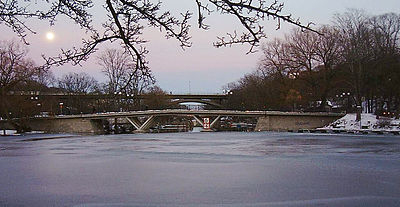 Långholmsbron (The bridge to Långholmen)
Långholmsbron (The bridge to Långholmen) -
-
Stockholm Walkabout V:
'The Green Island' formerly prison and more recently an oasis in the city center much like New York’s Central Park.
Leif Rosqvist on his latest Walkabout Tour of Stockholm, which takes him to Långholmen (The Long Islet) located between Stockholm’s Söder (southern district) and Kungsholmen islet in central Stockholm. Until 1975, it was a prison island, and with its beaches and forested areas an oasis in the city center much like New York’s Central Park. -
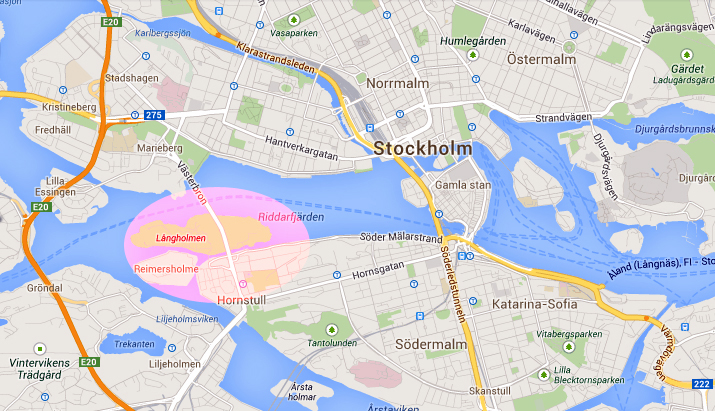 Map of central Stockholm.
Map of central Stockholm. -
-
Stockholm Walkabout V: Långholmen "The Green Island"
Swish! Went the guillotine when executor Alfred Dahlman released the blade, ending the life of Johan Alfred Ander on November 23, 1910. Ander was a convicted murderer and the last person to officially be executed in Sweden, and the only one to be executed by a guillotine at Långholmen Crown Prison in Stockholm.
Långholmen is one of Stockholm’s larger islands, also called “The Green Island,” and perhaps the one about which most myths and stories are told, mainly because of the old prison.
You can discover this for yourself, during my walking tour around the island; it is not only an exciting place, but a piece of unspoiled countryside within the city. A visit to the island can be a full-day excursion, with a walking tour, picnic and a refreshing swim in Lake Mälaren in the summertime. -
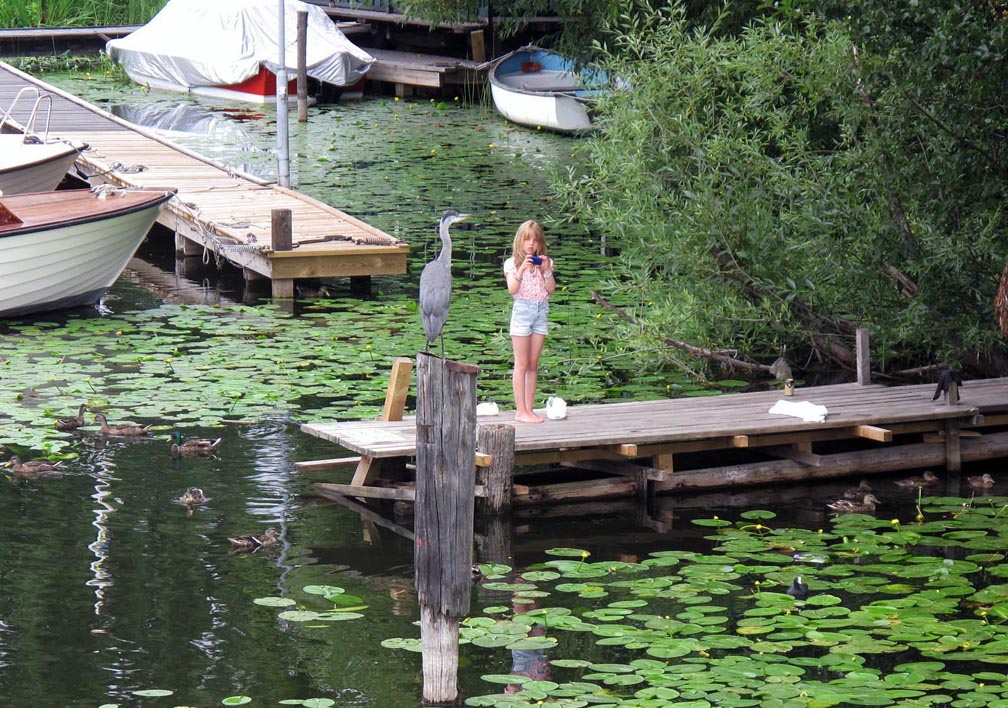 The girl with a heron - it doesn't get more summer-like than this.
The girl with a heron - it doesn't get more summer-like than this. -
I enter the island via Långholmsbron (the Long Islet Bridge), a bridge in central Stockholm connecting the major island Södermalm (Stockholm south) with the smaller island Långholmen. The bridge is an extension of the street Bergsundsgatan. (Rosqvist's earlier walk through Söder: Walkabout Tour of Stockholm II: Leif Rosqvist on a tour back to his roots on Stockholm’s Södermalm
-
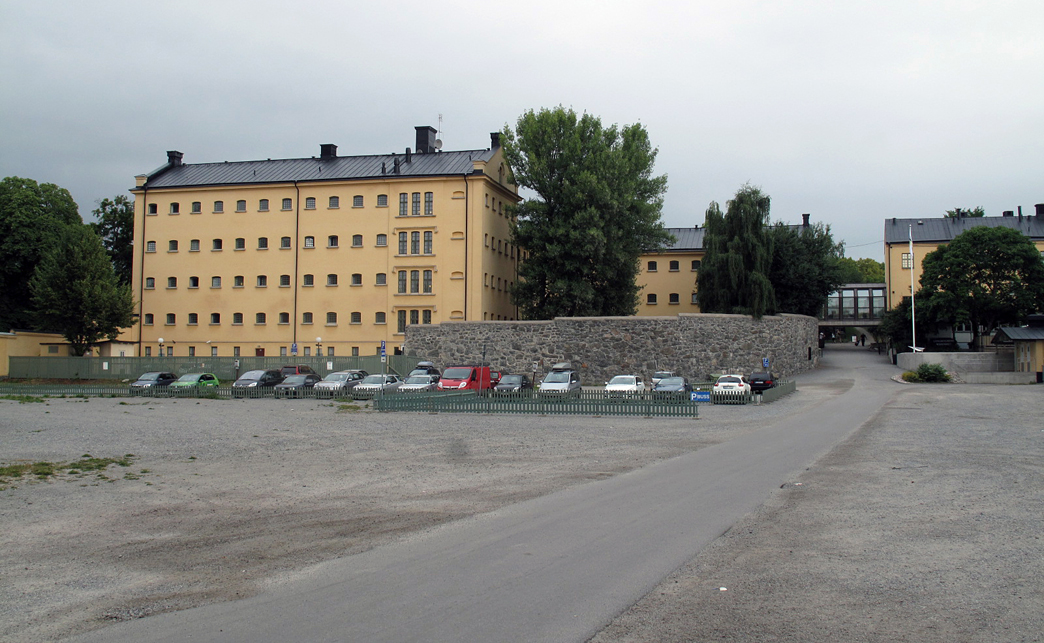 The old prison building.
The old prison building. -
Långholmsbron was earlier called Spinnhusbron (the Spinning House Bridge), in reference to the precursor to the Långholmen prison, and, popularly, Suckarnas bro (the Bridge of Sighs), also in reference to the prison, its present name stems from 1885. This section of the much larger Västerbron (the Western Bridge), the bridge passing over Långholmen connecting Stockholm south with Kungsholmen islet and the north, used to be called Långholmsbron.
Most likely, an old wooden bridge was found here in the mid 17th century, since it was the location for a customs house dealing with the ships delivering goods to the city from Lake Mälaren. It first appears on a map dated 1733, later replaced by a new wooden, four-span truss bridge in 1845, just over a hundred feet (33 meters) long, and 20 feet (6 meters) wide. In 1931, the present three-span steel girder bridge was inaugurated; 180 feet (56 meters) long and 26 feet (8 meters) wide with a roadway of 18 feet (5.6 meters).
This island housed a prison between 1724 and 1975—one of Sweden's bigger prisons with more than 500 cells. Since 1874 it was called Långholmens Centralfängelse (Långholmen Central Prison) or Långholmen Kronofängelse (Crown Prison). -
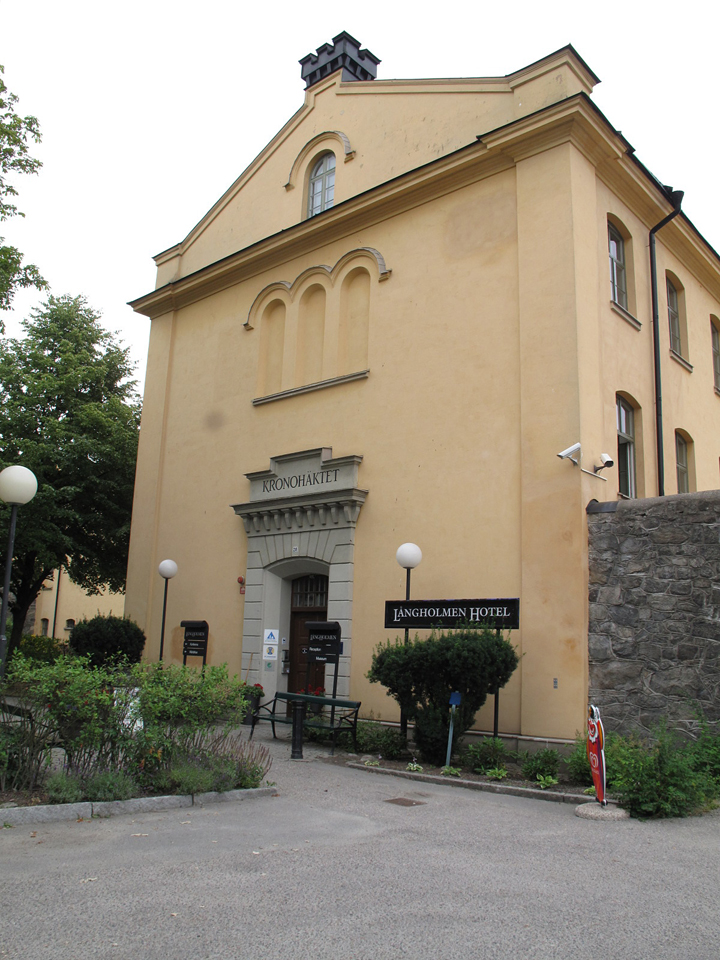 Today a hotel and conference, restaurant center
Today a hotel and conference, restaurant center -
Some notable prisoners have included:
• Johan Alfred Ander (1873-1910), convicted murderer, executed by guillotine in 1910.
• Barbro Alving (1909-1987), journalist and pacifist who refused to participate in civil defense, jailed for one month.
• Jan Guillou (1944- ), convicted of espionage at the time of the so-called “IB Affair” (1973), and sentenced to one year in prison, later lessened to 10 months.
• Hannes Skjöld (1886-1930), socialist, author and poet, sentenced for anti-militaristic propaganda.
• Hjalmar Branting (1860-1925), journalist and politician, the first Social Democratic Prime Minister of Sweden, imprisoned for three months for blasphemy while editing the Social-Demokraten newspaper.
• Zeth Höglund (1884-1956), a leading Swedish communist politician, anti-militarist, author, journalist and mayor (finansborgarråd) of Stockholm (1940–1950) served six months as a result of anti-war agitation.
• Ture Nerman (1886-1969), a Swedish socialist, journalist and author who was jailed for his part in the Trots allt! (Despite Everything!), an anti-Nazi paper that caused furor at the German Embassy in Stockholm.
• Colonel Stig Wennerström (1906-2006), the most well known prisoner was convicted for espionage and treason in 1964. During the 1950s, he leaked the Swedish air defense plans and the entire Saab Draken fighter jet project to the Soviet Union. -
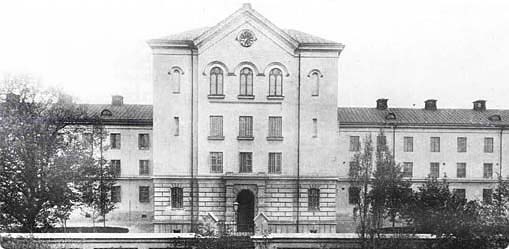 Långholmen prison, ca 1900
Långholmen prison, ca 1900 -
To say the least, this is a colorful and famous—or infamous—group of people.
-
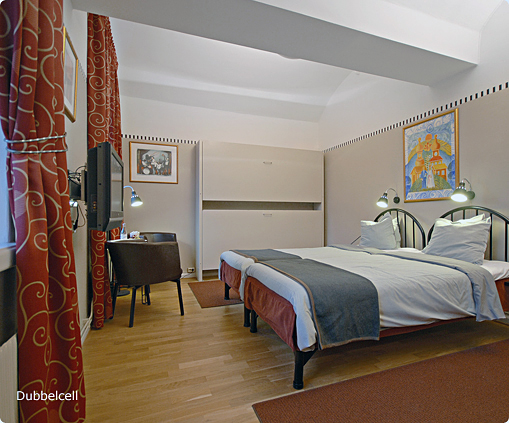 Modern room layout from 2 1/2 old cells
Modern room layout from 2 1/2 old cells -
Stockholm Midsummer dream
While crossing the bridge I observe a young girl standing on a dock trying to take a photo of a blue heron (grå häger) sitting close by on a pole in the water. In this picture we have all the ingredients of a Stockholm midsummer dream retained.
Straight ahead of me I see the impressive main prison building, and when I come closer I see a plaque on the building wall telling where the guillotine was placed during the execution of Johan Alfred Ander in November 1910.
The infamous Kronohäktet (Crown Prison) at Långholmen later became one of Sweden’s most famous hostels. A couple years ago The Times newspaper voted it to be one of the ten best hostels in Europe. The old cells were converted to comfortable hotel rooms, with single or double occupancy constructed by combining the cells. There are several excellent restaurants on the premises, and during our visit we had a wonderful dinner at the exclusive Wärdshuset restaurant (The Inn restaurant).
The breakfast we had at the small bar, in the same building as the hotel, was excellent.
After consuming a delightful dinner at the Wärdshuset we went to bed in our cozy “cell” and were ready to sleep when we heard whispering voices from the corridor in the cellblock. We peeked outside the door and in the dim light saw two men sitting at a table talking with each other. We went closer and saw it was the executor Alfred Dahlman and the prisoner Johan Alfred Ander sitting at the table over a bottle of beer talking about how well the guillotine worked.
Troubled, and on shaky legs we returned to our cell, thoroughly locked the door and finally fell into a deep sleep.
Obviously this is a bit of fiction, but the main point is that this is a top-notch hotel with a vivid history that must be discovered and experienced on the premises. -
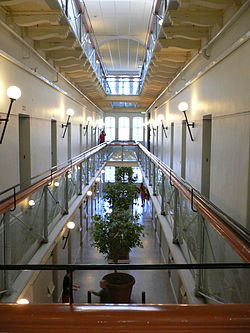 The “new Långholmen Hotel” superficially not so far from the prison look of earlier years.
The “new Långholmen Hotel” superficially not so far from the prison look of earlier years. -
Långholmen prison
We also had a private prison guide, Anneli Björkeen, who could tell all the stories about Långholmen and the prison. During scheduled guided tours, the guides are dressed in prison guard uniforms.
Following a hearty breakfast I walk to the side of the hostel and see Knapersta Estate. It consists of two buildings, Big and Small Knapersta, built during the 1700s by Immanuel Nobel, the father of the Nobel Prize creator Alfred Nobel. Classical landscaping and a beautiful garden adorn the front of the buildings, and songbirds are all over the bushes.
Story has it young Alfred was playing with explosives and after one of his friends was hurt in an accident, the experiments were moved away from the island to a safer place.
I continue my walk along a small road to Sofieberg, which is the far western part of the island. There are two remaining buildings here that were built according to the late 1800s architecture style: The “Red House” and the more interesting “Green House.” The Green House was built with plenty of Swedish “snickarglädje” (gingerbread style with lots of “carpenter’s joy”). In the past the Sofieberg property included the entire western cape of Långholmen, and in the mid-1970s, when the prison era ended, the area was made accessible to the public.
On the opposite side of the cape we find the Karlshälls Gård (“farm built as a mansion”), an impressive and beautiful facility. The property is now mainly used as a conference center and with its beautiful—albeit somewhat over-grown—gardens, is definitely worth a visit. -
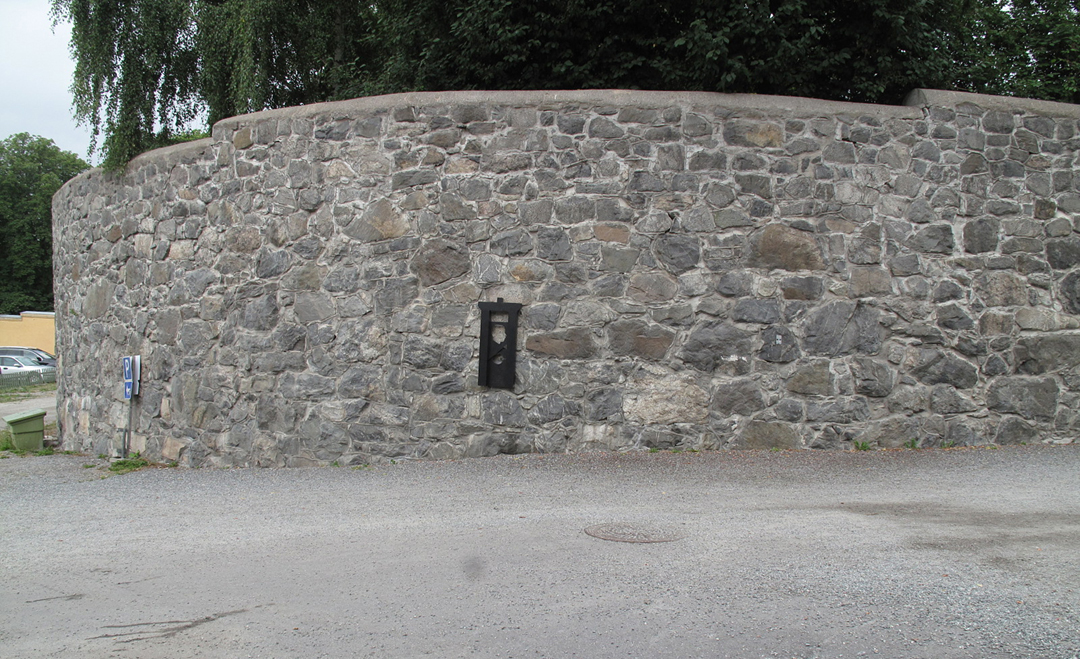 Plaque on the wall indicating where the guillotine was placed at the time of its use.
Plaque on the wall indicating where the guillotine was placed at the time of its use. -
'Brännvinskriget'
An interesting period of the Karlshälls Gård was during the heated “brännvinskriget” (the aquavit war), during 1870-1880, between the owner of Reimersholme Distillery, L.O. Smith (brännvinskungen, the King of Aquavit) and the distillery of Stockholms Utskänkningsbolag (the [alcohol] Providing Company of Stockholm). Smith had set up production of alcohol on the island Reimersholme adjacent to Långholmen, which was listed as property in Brännkyrka assembly outside the Providing Company’s jurisdiction, making it possible for him to work around the local ordinance to sell alcohol. The sale of his better distilled and superior absolut rent brännvin (absolutely pure alcohol) was for a time moved to Fjäderholmarna, just outside the Stockholm harbor, to ensure distribution.
After a long time peace was established between the warring parties, but not without several incarcerations of involved parties at Riddarholmen and Långholmens prisons.
I am continuing my walk to the northern side of the island and I see two places for public bathing, one including a fabulous view of downtown Stockholm. I ask an older lady swimming in the lake: “How is the water, is it cold”? She answers that the water is nice, so jump in. -
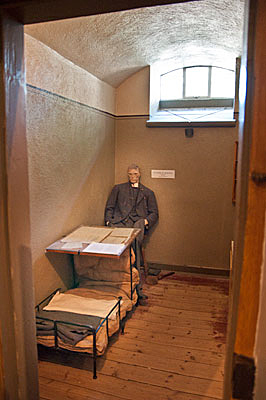 Old cell layout
Old cell layout -
Just as I’m walking around the eastern cape I see the small cruise ship m/s Prins Carl Philip passing by. I have been told that if you call the captain, he stops to pick you up. I never tried and don’t know if it’s true, but it’s tempting, as it is only a five to 10 minute boat ride from the Town Hall in Stockholm. Instead, I continue my walk.
After a short while I’m reaching the eastern side of the island and see Mälarvarvet (Mälaren Shipyard Warf) in front of me, which is the last shipyard warf on Långholmen located at the southeastern point of the island. The warf has a history going back to the 1680s, but in 2007 the warf owner went into bankruptcy and an industrial period of central Stockholm came to an end.
As I’m closing in on the western section of Pålsundsbron, the easternmost bridge connecting Långholmen with Stockholm south, I see a building called “Fördärvet” (The Blight). In the mid-1800s this was a bar from which the building got its name. It was a place where you could “fördärva” (mar or lose) your economy and your health if not careful. The name is speaking for itself and is in the same category as Pungpinan (when one torments the purse to pay for the alcohol) and Sista Styvern (a bar where the seamen had their last snaps prior to going back to sea, or where prisoners had their last snaps prior to their hanging).
With all these impressive images in my mind I’m crossing Pålsundsbron and slowly walk back to the bus station to get back to my mother’s apartment for dinner. -
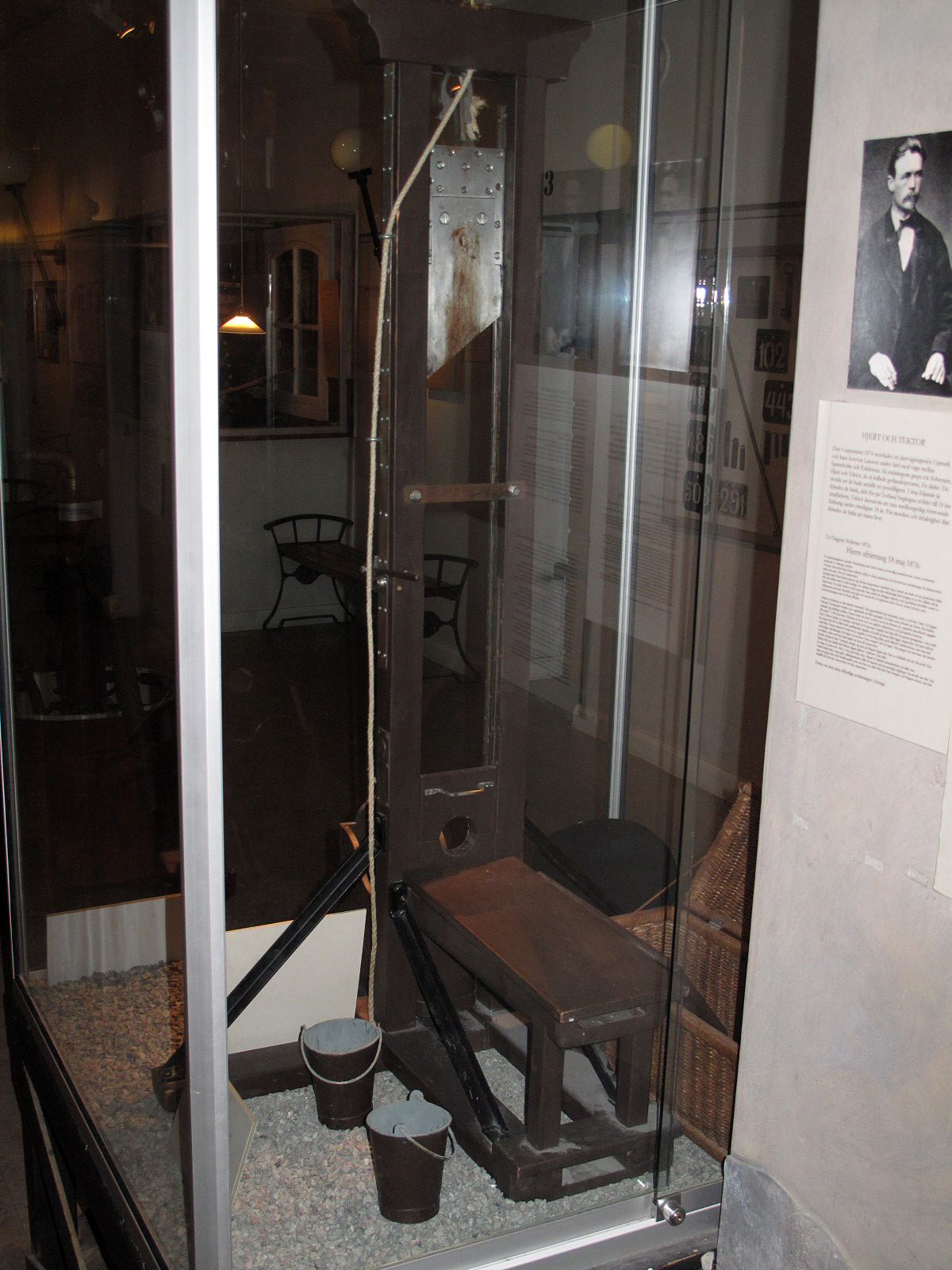 Model of the Guillotine in the museum.
Model of the Guillotine in the museum. -
More information for the interested:
- Wikipedia: Långholmen
- Wikipedia: Södermalm i tid och rum. Stockholm (in Swedish only)
- Stockholm's Stadsbibliotek: Stockholmskällan -
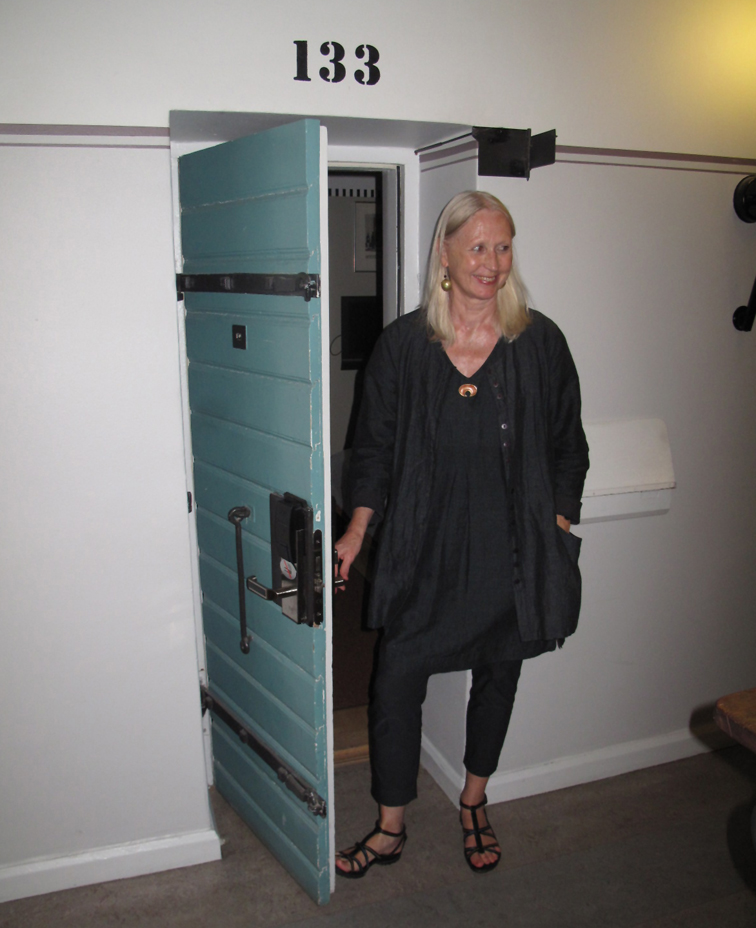 Our guide, Anneli Björkeen
Our guide, Anneli Björkeen -
Leif’s earlier Walkabout Tours of Stockholm are also online: I on Gamla Stan (The Old Town) Walkabout Tour of Stockholm I - a stroll through the Old Town, 'Gamla Stan'; II on central Söder (Stockholm South); III on Djurgården and the old navy shipyards; and, IV on Söder, Hornsgatan and Slussen
-
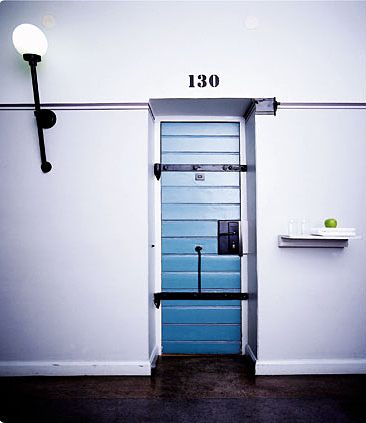 Cell/Room complex Our cell/room number
Cell/Room complex Our cell/room number -
-
-
